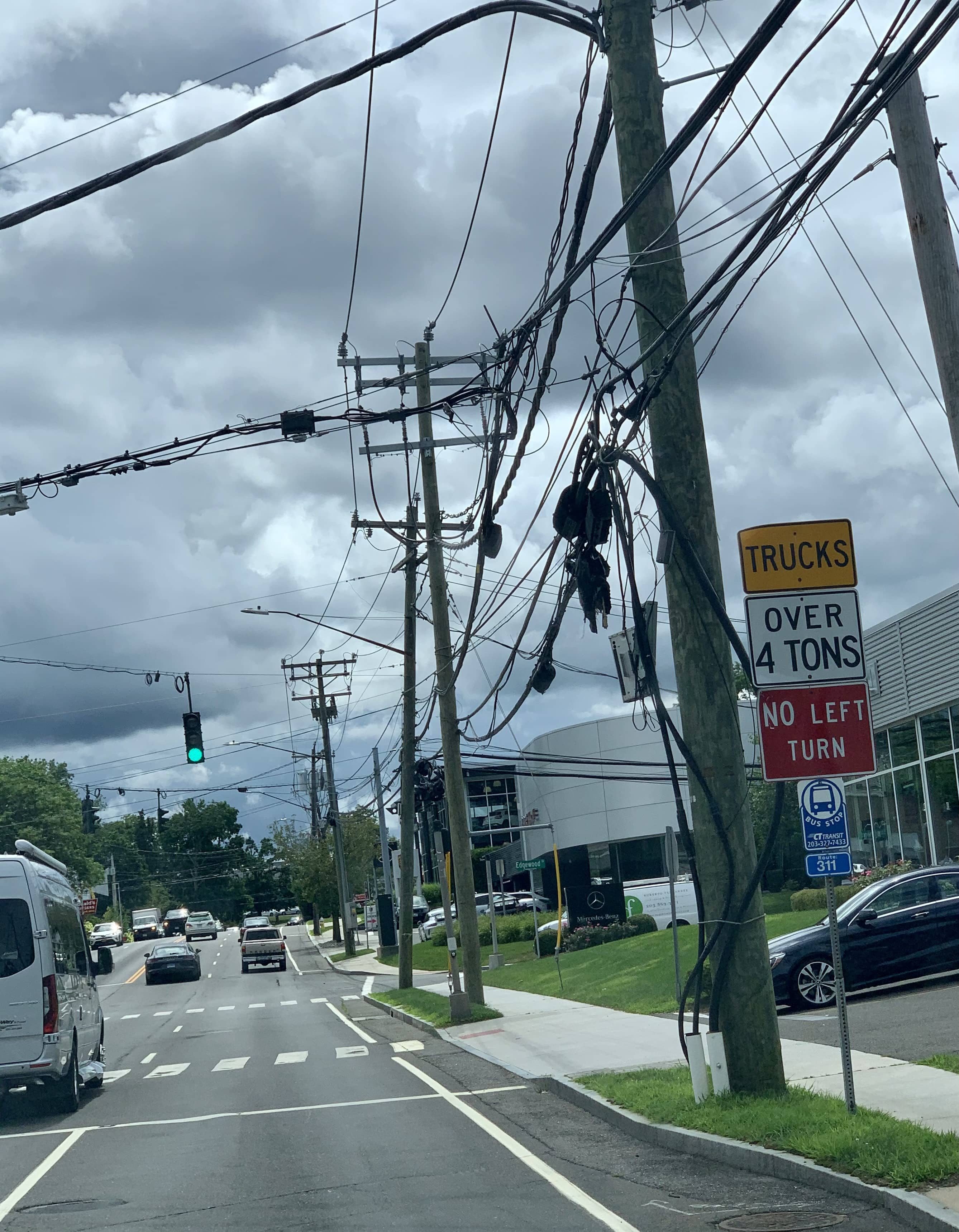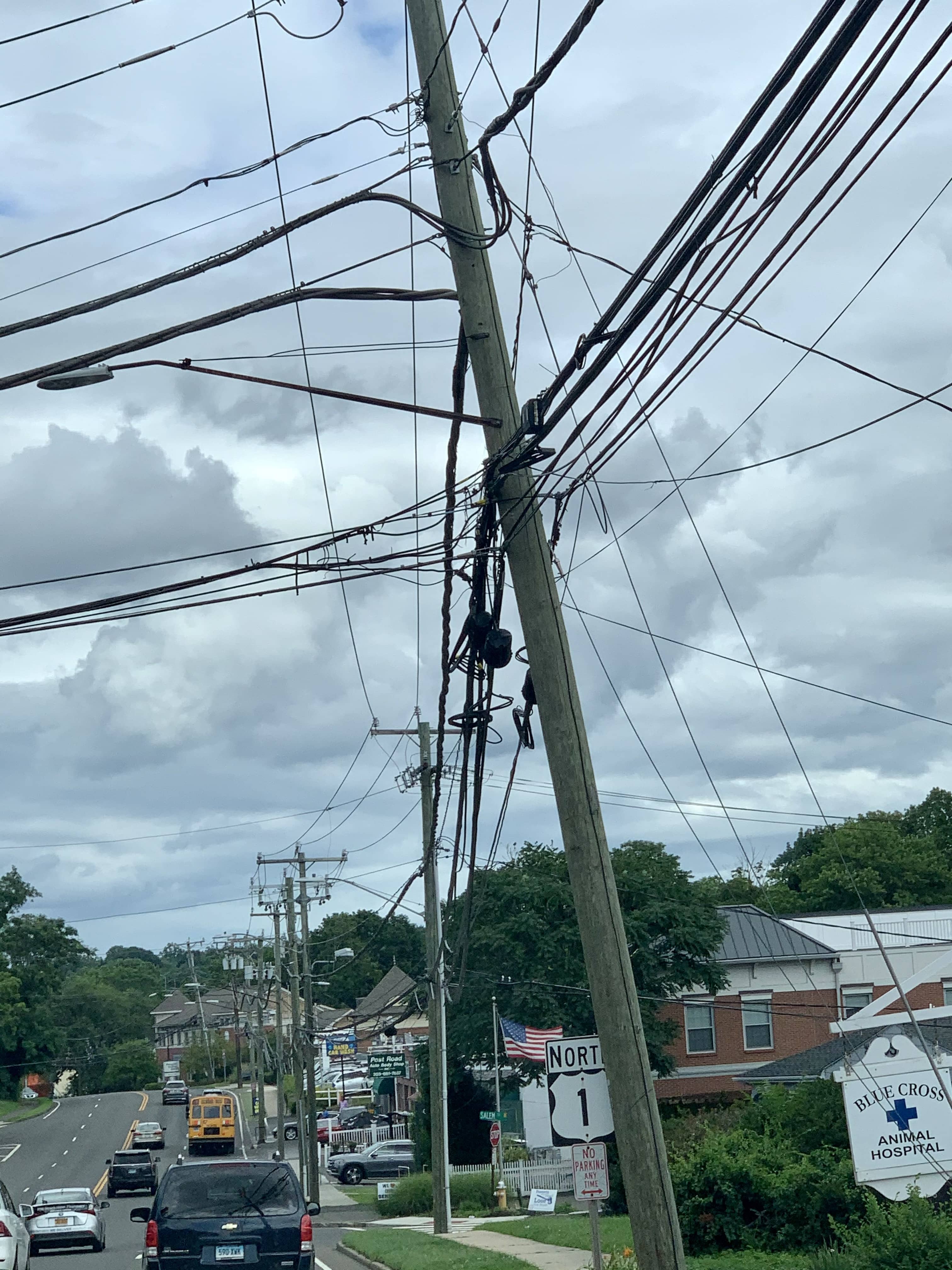

By Anne W. Semmes
There are some impressive individuals in Greenwich invested in the betterment of our town. They include “influencers” introduced by our esteemed citizen Peter Malkin in high hopes they will revive his campaign to better beautify and safeguard his hometown by the burying of its power lines underground. So, this reporter reached out to those influencers to learn their interest.
Former First Selectman Jim Lash
“You might start with former First Selectman Jim Lash,” Malkin suggests. During his First Selectman tenure (2003-2007), Lash tells, “We had enough of a storm problem that we were able to persuade them [the power company] that we needed to actually begin to put some of these cables underground. They agreed to form a little committee, and they did some work with this. It was primarily focused on the downtown area, but they never finished the work…”
For Lash, “Undergrounding cable is something that they [power company] ought to view as improving the operation of their system. But they don’t view it that way. They prefer lines up on poles that they can see as they drive down the road. And their solution to the power outages is to take down trees and change the appearance of the area as they go along.”
So how to get that undergrounding going with a reluctant power company? “The town,” says Lash, “borrows the money. It in effect contracts with the power company to underground the cables. The power company agrees to maintain them once they are installed, and the town bills the money back to the residents. The town borrows the money for 20 years, and it gets added to the taxes of the people it serves. And they pay it back gradually over the 20 years and that’s frankly cheaper than having the power company do it because they’ll add a large profit on top of it.”
Former First Selectman Peter Tesei
“Yes, this initiative can be undertaken,” agrees Peter Tesei, who succeeded Lash as First Selectman (2007-2019), but “with the support of Eversource and willingness upon the stakeholders, (residents/taxpayers/rate payers) to fund this over an extended period of time.”
Tesei had met up with ‘all of the utilities – notably Eversource” in his office, with the laying out of the process and cost “to relocate electrical wires underground along Field Point Road leading to the Hospital and the peripherally of the Central Business District where there are many elderly residents living in apartment buildings. This was meant as an initial demonstration project to provide cost.
“We also mapped out doing a neighborhood that was selected due to its vulnerability and proximity to a critical senior care facility. Of course, the telecommunications utilities participated because they too would have to relocate their wires underground.” But in the end, tells Tesei, “the question on who will pay for it stalled the effort.” Yet, he adds importantly, “The groundwork was laid to reignite the initiative.”
First Selectman Fred Camillo
And so has our present First Selectman Fred Camillo had a track record of trying to push forward that undergrounding initiative. Earlier, in 2011, then State Rep Camillo had arranged a public forum on burying power lines. The unfortunate bombshell that came out of that meeting was the news making projected cost given by the then town serving utility CL&P of $1.2 billion to bury 347 miles of overhead utilities.
But Malkin, ever present, had encouraged attendees with a thought valid even today: “We have a time of historically low interest rates, and you’ll never have a better time to get long-term financing. It would provide jobs, be low lost and you could get bonds and spread the cost out over years.” Camillo had ended the meeting with, “This is only a beginning. A good start.”
First Selectman Camillo at present is a bit overwhelmed with his list of initiatives for the town but ever ready to pursue that undergrounding dream. “I’m a proponent,” he says, and if a committee of influencers should coalesce, “They can meet in my office.”
Elizabeth Hopley
Elizabeth Hopley is another Greenwich proponent who’s attended those power burying forums. She recalls legislator Camillo expressing to her noticing “these ugly lines everywhere” on Greenwich streets. Hopley, who is a former executive in the fashion and luxury goods industry, had lived in Germany as a high schooler and seen no overhead lines. “So, when you get used to that and you come back here,” she says, “it looks like a third world country.”
Hopley has leant her expertise to the Greenwich Land Trust and Greenwich Tree Conservancy, and as a member of the Greenwich Garden Club put together for the Garden Club of America an impressive document addressing “the serious and persistent issue of our antiquated, failing electrical infrastructure in Connecticut.” Through this advocacy she has shared with Senators Blumenthal, Murphy, and Rep, Himes that “burying the lines makes sense and addresses so many issues through this one initiative.”
Recalling that earlier 2011 forum that brought such sticker shock, Hopley notes, “They talked about this would be a 30-year project and it would cost about $3,000 per household as unaffordable for people. And so I’m thinking, Wait a minute, $3,000, over 30 years, is really only $100 a year. That’s less than what their rate increases are. We pay the highest rates per kilowatt hour after Hawaii. Even California is slightly less than we are.”
Leslie Lee
Leslie Lee, a Malkin “influencer” having worn many a conservation hat, expresses her hope that “the utilities will stop giving unsubstantiated estimates on the costs of burying electric wires and would provide a sensible plan for phased in undergrounding, starting with the main transition lines between sub-stations and power cables in more densely populated areas and then moving progressively into the wider town. “
The money the power company spends on their tree trimming programs and storm cleanup efforts Lee notes, would be better spent on a scheduled program of burying electric lines, that would prevent future storm damage to the lines.
Cheryl Dunson
Tree advocate Cheryl Dunson, president of Greenwich Tree Conservancy especially protests that “tree trimming.” “At the same time that we have a worldwide call to plant more trees to mitigate climate change,” she states, “Eversource’s ‘adaptation strategy’ is to cut down and/or excessively prune trees leaving them weakened and unsightly. The loss of trees in turn contributes to worsening climate change impacts. Connecticut needs to strategically underground power and telecommunications lines as an adaptation/resiliency strategy.”
Dunson cites the continuing reliance on a pole distribution system as “failing to acknowledge the worsening effects of climate change. The Governor’s Council on Climate Change recently issued a report which noted disturbing trends: higher and more frequent temperature events, increasing drought risks, continued high winds and high precipitation from storms.”
Mitch Mailman
The last words – and some tough ones – come from another Malkin influencer from the other side of the fence, Mitch Mailman, power line constructor, home-based on the Greenwich-Stamford border, with a portfolio of dealing with some 50 utilities across the country. “I worked for the town of Greenwich pro bono when Eversource was planning to do their big major job through Bruce Park. That was how I met Mr. Malkin.”
So, how, Mailman is asked, do we get Eversource to go forward with undergrounding Greenwich? “Why do you want to do that?” he asks. “Because of climate change, storms, environment.” “So, your focus is reliability. You don’t like the fact that if there’s a major windstorm you can be without lights for six days. That’s a very serious issue – lack of reliability. And the way the system is built in Greenwich, it’s inherently unreliable. So, what you really would want to have happen in a perfect world would be that the circuits be undergrounded because that would aesthetically improve the vision, but it would also give you greater reliability.
“What you really have to do is isolate areas that have repeated outages, where undergrounding will work. Any undergrounding project has to be done in conjunction with making Greenwich more reliable electrically. If you decided tomorrow, whatever it is, you have unlimited resources, it would take you conceivably a year to underground the first few miles by the time the designs done. The point is you have to improve the reliability now, even if you choose to go underground.
“One of the problems in Greenwich is that there are not a lot of circuits. And as a result, each circuit has more and more customers on it. So, let’s say that circuit right now has 1000 customers. So, 1000 customers are now out of light, because that tree fell over.
“Right now, the utility business is strictly a printing press for money. If you are a utility, and you make an investment in transmission, you are guaranteed a return on that investment
So, it’s difficult to get the utilities to do anything but major transmission projects.
But, what about this new trenchless drilling – isn’t that making undergrounding more cost effective and faster? “We directional drill every day. Whoever told you it’s faster and cheaper is dreaming. And large parts of Greenwich are solid rock.”
Mailman ended his commentary with praise for the undergrounding influencers. “These guys have great ideas and I admire their passion. Their attitudes are laudable, to leave the world a better place than they found it. But in this case the key is reliability. These guys really want to push – that’s what they have to push for.”
You can read the column that sparked this article HERE.



